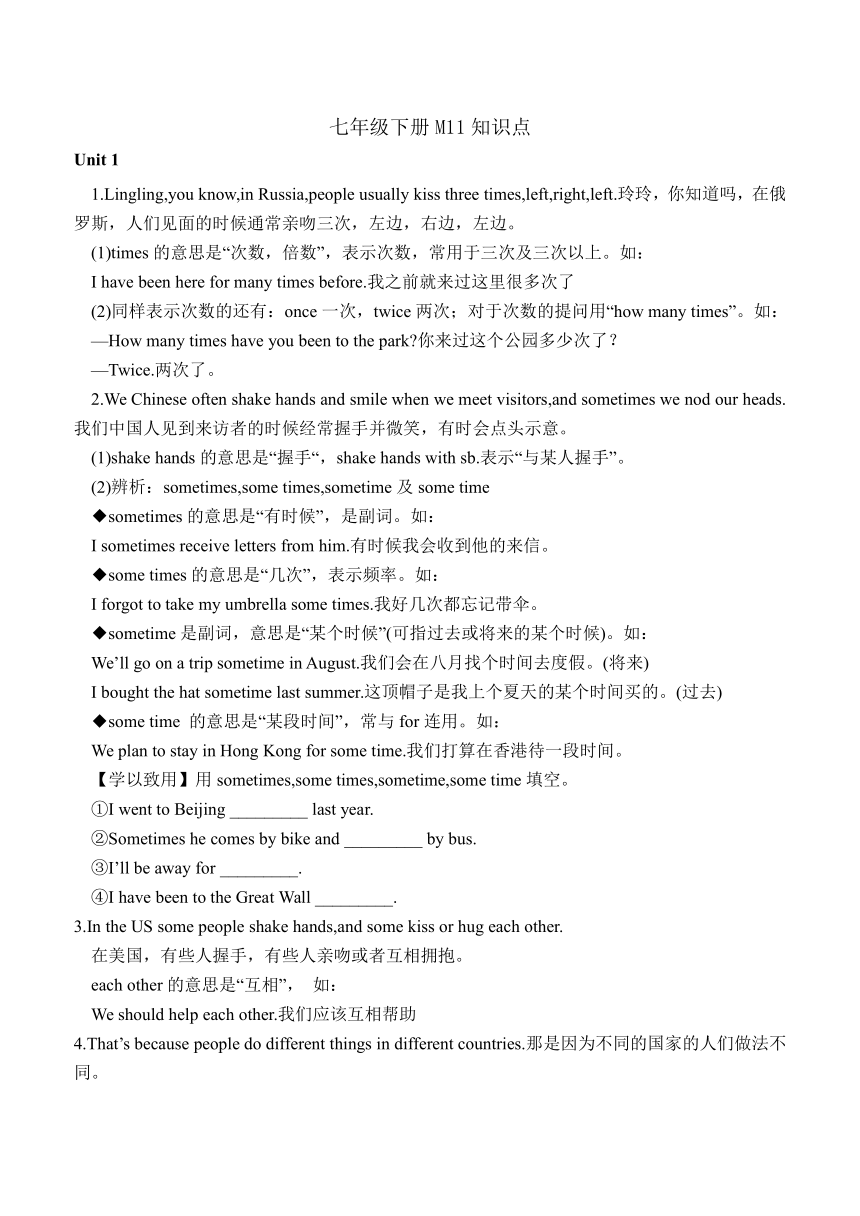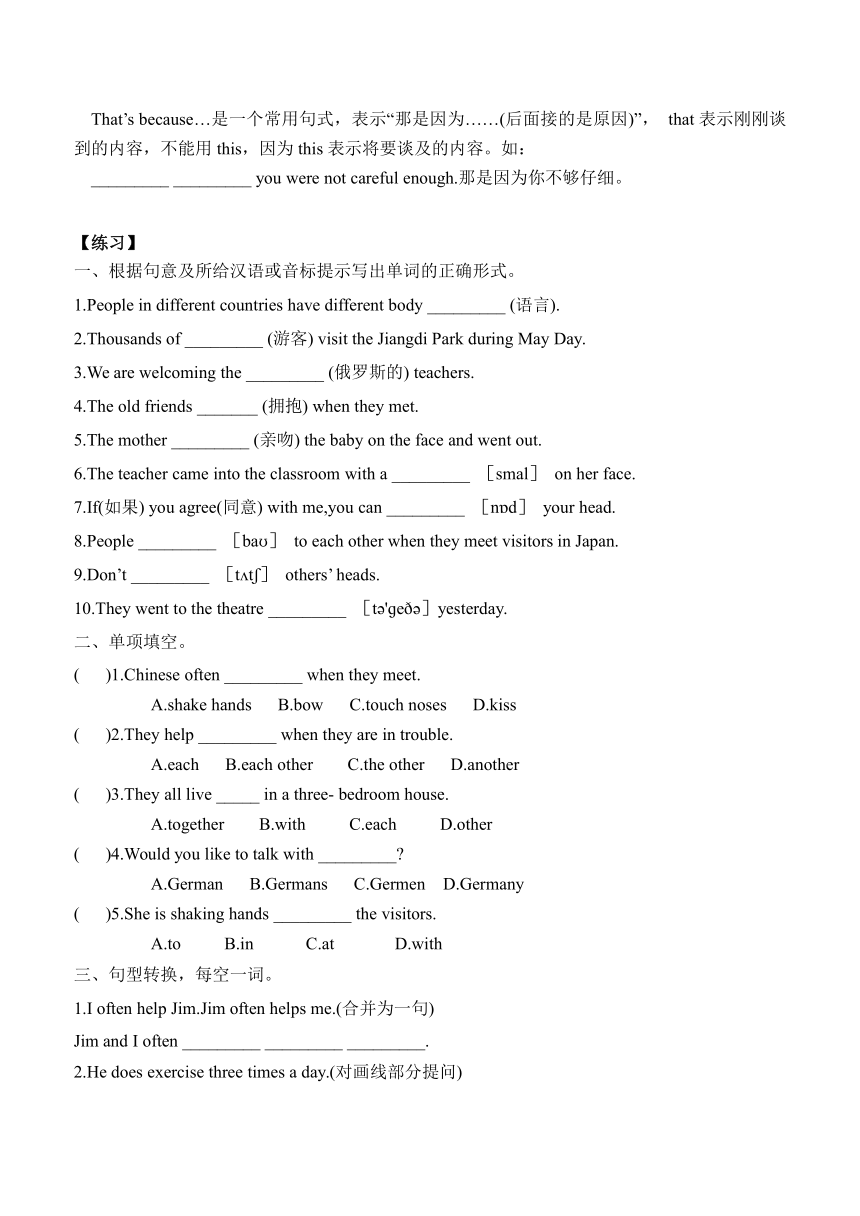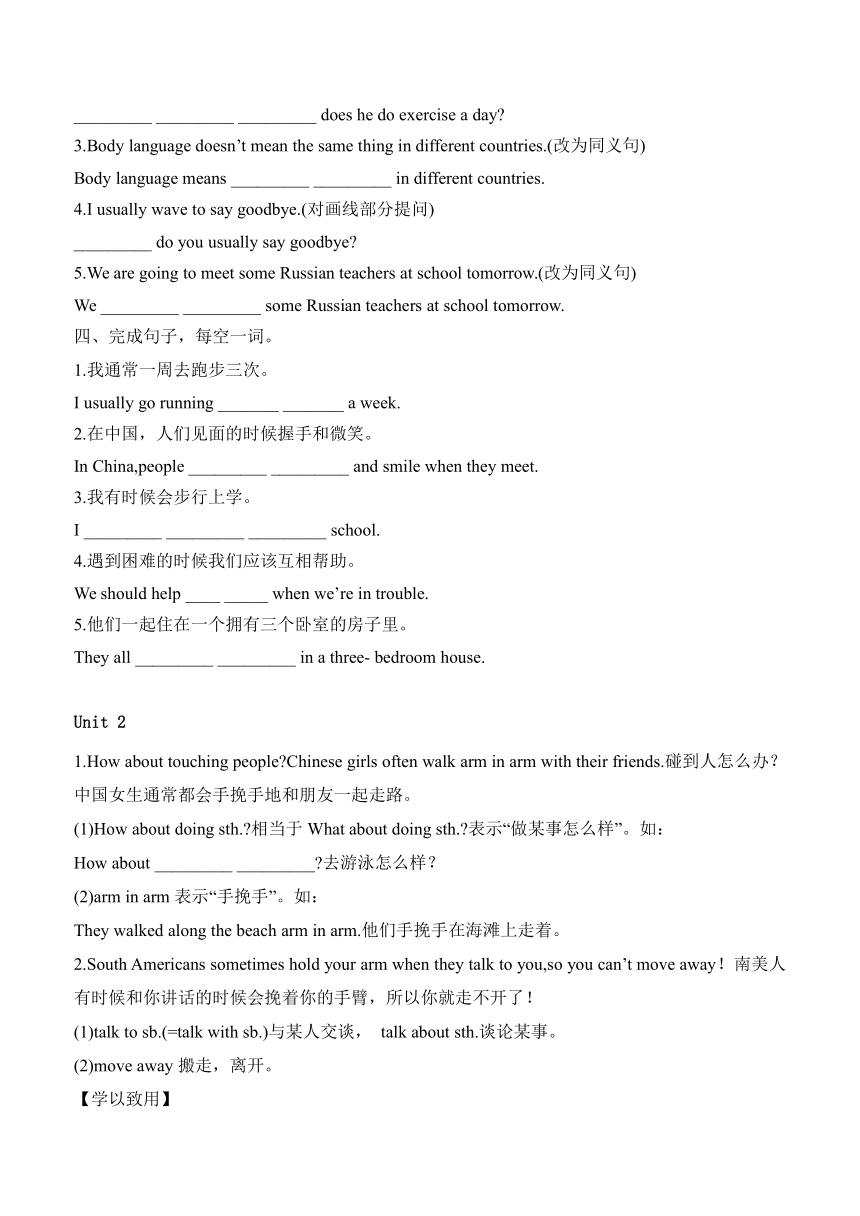外研版英语七年级下册Module11 Body language复习学案及练习(无答案)
文档属性
| 名称 | 外研版英语七年级下册Module11 Body language复习学案及练习(无答案) |  | |
| 格式 | docx | ||
| 文件大小 | 26.2KB | ||
| 资源类型 | 教案 | ||
| 版本资源 | 外研版 | ||
| 科目 | 英语 | ||
| 更新时间 | 2024-03-31 22:09:51 | ||
图片预览



文档简介
七年级下册M11知识点
Unit 1
1.Lingling,you know,in Russia,people usually kiss three times,left,right,left.玲玲,你知道吗,在俄罗斯,人们见面的时候通常亲吻三次,左边,右边,左边。
(1)times的意思是“次数,倍数”,表示次数,常用于三次及三次以上。如:
I have been here for many times before.我之前就来过这里很多次了
(2)同样表示次数的还有:once一次,twice两次;对于次数的提问用“how many times”。如:
—How many times have you been to the park 你来过这个公园多少次了?
—Twice.两次了。
2.We Chinese often shake hands and smile when we meet visitors,and sometimes we nod our heads.我们中国人见到来访者的时候经常握手并微笑,有时会点头示意。
(1)shake hands的意思是“握手“,shake hands with sb.表示“与某人握手”。
(2)辨析:sometimes,some times,sometime及some time
◆sometimes的意思是“有时候”,是副词。如:
I sometimes receive letters from him.有时候我会收到他的来信。
◆some times的意思是“几次”,表示频率。如:
I forgot to take my umbrella some times.我好几次都忘记带伞。
◆sometime是副词,意思是“某个时候”(可指过去或将来的某个时候)。如:
We’ll go on a trip sometime in August.我们会在八月找个时间去度假。(将来)
I bought the hat sometime last summer.这顶帽子是我上个夏天的某个时间买的。(过去)
◆some time 的意思是“某段时间”,常与for连用。如:
We plan to stay in Hong Kong for some time.我们打算在香港待一段时间。
【学以致用】用sometimes,some times,sometime,some time填空。
①I went to Beijing _________ last year.
②Sometimes he comes by bike and _________ by bus.
③I’ll be away for _________.
④I have been to the Great Wall _________.
3.In the US some people shake hands,and some kiss or hug each other.
在美国,有些人握手,有些人亲吻或者互相拥抱。
each other的意思是“互相”, 如:
We should help each other.我们应该互相帮助
4.That’s because people do different things in different countries.那是因为不同的国家的人们做法不同。
That’s because…是一个常用句式,表示“那是因为……(后面接的是原因)”, that表示刚刚谈到的内容,不能用this,因为this表示将要谈及的内容。如:
_________ _________ you were not careful enough.那是因为你不够仔细。
【练习】
一、根据句意及所给汉语或音标提示写出单词的正确形式。
1.People in different countries have different body _________ (语言).
2.Thousands of _________ (游客) visit the Jiangdi Park during May Day.
3.We are welcoming the _________ (俄罗斯的) teachers.
4.The old friends _______ (拥抱) when they met.
5.The mother _________ (亲吻) the baby on the face and went out.
6.The teacher came into the classroom with a _________ [smal] on her face.
7.If(如果) you agree(同意) with me,you can _________ [n d] your head.
8.People _________ [ba ] to each other when they meet visitors in Japan.
9.Don’t _________ [t t ] others’ heads.
10.They went to the theatre _________ [t 'ɡe ]yesterday.
二、单项填空。
( )1.Chinese often _________ when they meet.
A.shake hands B.bow C.touch noses D.kiss
( )2.They help _________ when they are in trouble.
A.each B.each other C.the other D.another
( )3.They all live _____ in a three- bedroom house.
A.together B.with C.each D.other
( )4.Would you like to talk with _________
A.German B.Germans C.Germen D.Germany
( )5.She is shaking hands _________ the visitors.
A.to B.in C.at D.with
三、句型转换,每空一词。
1.I often help Jim.Jim often helps me.(合并为一句)
Jim and I often _________ _________ _________.
2.He does exercise three times a day.(对画线部分提问)
_________ _________ _________ does he do exercise a day
3.Body language doesn’t mean the same thing in different countries.(改为同义句)
Body language means _________ _________ in different countries.
4.I usually wave to say goodbye.(对画线部分提问)
_________ do you usually say goodbye
5.We are going to meet some Russian teachers at school tomorrow.(改为同义句)
We _________ _________ some Russian teachers at school tomorrow.
四、完成句子,每空一词。
1.我通常一周去跑步三次。
I usually go running _______ _______ a week.
2.在中国,人们见面的时候握手和微笑。
In China,people _________ _________ and smile when they meet.
3.我有时候会步行上学。
I _________ _________ _________ school.
4.遇到困难的时候我们应该互相帮助。
We should help ____ _____ when we’re in trouble.
5.他们一起住在一个拥有三个卧室的房子里。
They all _________ _________ in a three- bedroom house.
Unit 2
1.How about touching people Chinese girls often walk arm in arm with their friends.碰到人怎么办?中国女生通常都会手挽手地和朋友一起走路。
(1)How about doing sth. 相当于What about doing sth. 表示“做某事怎么样”。如:
How about _________ _________ 去游泳怎么样?
(2)arm in arm表示“手挽手”。如:
They walked along the beach arm in arm.他们手挽手在海滩上走着。
2.South Americans sometimes hold your arm when they talk to you,so you can’t move away!南美人有时候和你讲话的时候会挽着你的手臂,所以你就走不开了!
(1)talk to sb.(=talk with sb.)与某人交谈, talk about sth.谈论某事。
(2)move away搬走,离开。
【学以致用】
①My head teacher wanted to _________ _________ me.班主任想和我谈一谈。
②My best friend _________ _________ last month.我最好的朋友上个月搬走了。
3.In some places,it isn’t polite to look at people when you talk,but in other countries it isn’t polite to look somewhere else.在一些地方,当你说话的时候看着别人是不礼貌的,但在其他一些国家(交谈时)看别的地方是不礼貌的。
(1)It is +adj.+ for sb.to do sth.意为“某人做某事是怎么样的”。It是这个句型的形式主语,真正的主语是后面的不定式短语。
(2)polite形容词,意为“礼貌的”,其反义词为impolite或rude。常用结构:be polite to do sth.。
(3)somewhere副词,意为“某处,某个地方”,通常用于肯定句。形容词修饰somewhere时,应放在somewhere后面。
【学以致用】
①It is important to _________ _________ ________ strangers.对陌生人有礼貌是很重要的。
②I want to go _________ _________ to take a vacation.我想去一个凉爽的地方度假。
4.That’s easy,wave to say goodbye.But be careful!In Greece,it’s not at all polite!In fact,it’s very rude!那很简单,挥手告别。但是要小心!在希腊,这一点儿也不礼貌!事实上,这是很粗鲁的!
(1)wave意为“挥手,招手”;wave to sb.意为“向某人挥手”。
(2)be careful意为“小心,当心”,相当于watch out,look out。
(3)not at all意为“一点也不,根本不”。
(4)in fact意为“事实上”。fact名词,意为“事实,细节”。
(5)rude形容词,意为“粗鲁的”,其副词形式是rudely,名词形式为rudeness。be rude to sb.意为“对某人无礼,对某人粗鲁”。
【练习】
一、根据句意及首字母提示,用单词的适当形式填空。
1.The boy wants more p_________ space.
2.Mary is w_________ her right arm to say goodbye.
3.People in different countries use different b______ language when they meet.
4.It’s r_________ to shout at people.
5.My leg was hurt,and I can’t m_________ now.
二、根据句意用括号内所给单词的适当形式填空。
1.There will be some _________ (foreign) visiting our school this Friday.
2.It’s _________ (polite) to eat with your mouth full.
3.The box is too heavy.I can’t _________ (hold) it up.
4.The shoes are too big for my _________ (foot).
5.The body language in _________ (British) is different from the US.
三、完成句子,每空一词。
1.有礼貌地对待你的老师和朋友。
_______ _______ to your teachers and friends.
2.我一点儿也不喜欢和其他人接触。
I don’t like _______ others ________ _______.
3.希腊人挥手告别吗?
Do people in Greece _________ _________
4.当心!那辆车正在开过来。
_________ _________!The car is coming.
5.我妈妈还没回来,所以你不能离开。
My mother isn’t in,so you can’t ______ ______.
Unit 3
祈使句
祈使句是用来表示请求、命令、劝告、建议等意义的句子。
1.祈使句的特点。
(1)祈使句一般没有主语,说话的对象都是第二人称“你”或“你们”,可理解为省略了主语you。
(2)以动词原形开头,无时态和数的变化;
(3)祈使句的否定形式可以在动词原形前加don’t。
2.祈使句的类型。
(1)肯定句型
①Do型。 句型结构:实义动词原形(+宾语+其他).如:Listen!听!
Close the door,please.请关上门。
②Be型。句型结构:Be动词+表语 (+其他).如:Be quiet.安静。
③Let型。句型结构:Let+宾语+动词原形(+其他).如:Let me help you.让我帮你吧。
(2)否定形式
①Don’t型。 句型结构:Don’t +动词原形(+其他).如:Don’t worry.不要担心。
②No 型。句型结构: No+ 动词的- ing形式/名词复数。如:
No smoking.禁止吸烟。
No photos.禁止拍照。
【练习】
一、单项填空。
( )1._________ parking.
A.Not B.No C.Don’t D.Must
( )2.Sindy,_________ to be here at 8 o’clock.
A.be sure B.is sure C.will be sure D.is sure that
( )3.Mary,_________ here—everybody else,stay where you are.
A.come B.comes C.to come D.coming
( )4.He is not honest._________ believe him.
A.Not B.Don’t C.To not D.Not to
( )5._________ go for the book alone,Ms Zhang.
A.Let’s B.Let me C.Let us D.Allow
二、句型转换。
1.Come here early.(改为否定句)
_______________________
2.You can’t take your dog to school.(改为祈使句)
_______________________
3.Let’s go there together.( 改为否定句)
_______________________
4.Don’t let them play here.(改为肯定句)
_______________________
5.请照看(look after)好你的包包。(翻译成英文)
_______________________
三、用括号内所给动词的适当形式填空。
1.It’s an important meeting._________ (not,be) late.
2._________ (look) out!A car is coming.
3._________ (not,let) the baby cry.
4.Let’s _________ (not,say) anything about it.
Unit 1
1.Lingling,you know,in Russia,people usually kiss three times,left,right,left.玲玲,你知道吗,在俄罗斯,人们见面的时候通常亲吻三次,左边,右边,左边。
(1)times的意思是“次数,倍数”,表示次数,常用于三次及三次以上。如:
I have been here for many times before.我之前就来过这里很多次了
(2)同样表示次数的还有:once一次,twice两次;对于次数的提问用“how many times”。如:
—How many times have you been to the park 你来过这个公园多少次了?
—Twice.两次了。
2.We Chinese often shake hands and smile when we meet visitors,and sometimes we nod our heads.我们中国人见到来访者的时候经常握手并微笑,有时会点头示意。
(1)shake hands的意思是“握手“,shake hands with sb.表示“与某人握手”。
(2)辨析:sometimes,some times,sometime及some time
◆sometimes的意思是“有时候”,是副词。如:
I sometimes receive letters from him.有时候我会收到他的来信。
◆some times的意思是“几次”,表示频率。如:
I forgot to take my umbrella some times.我好几次都忘记带伞。
◆sometime是副词,意思是“某个时候”(可指过去或将来的某个时候)。如:
We’ll go on a trip sometime in August.我们会在八月找个时间去度假。(将来)
I bought the hat sometime last summer.这顶帽子是我上个夏天的某个时间买的。(过去)
◆some time 的意思是“某段时间”,常与for连用。如:
We plan to stay in Hong Kong for some time.我们打算在香港待一段时间。
【学以致用】用sometimes,some times,sometime,some time填空。
①I went to Beijing _________ last year.
②Sometimes he comes by bike and _________ by bus.
③I’ll be away for _________.
④I have been to the Great Wall _________.
3.In the US some people shake hands,and some kiss or hug each other.
在美国,有些人握手,有些人亲吻或者互相拥抱。
each other的意思是“互相”, 如:
We should help each other.我们应该互相帮助
4.That’s because people do different things in different countries.那是因为不同的国家的人们做法不同。
That’s because…是一个常用句式,表示“那是因为……(后面接的是原因)”, that表示刚刚谈到的内容,不能用this,因为this表示将要谈及的内容。如:
_________ _________ you were not careful enough.那是因为你不够仔细。
【练习】
一、根据句意及所给汉语或音标提示写出单词的正确形式。
1.People in different countries have different body _________ (语言).
2.Thousands of _________ (游客) visit the Jiangdi Park during May Day.
3.We are welcoming the _________ (俄罗斯的) teachers.
4.The old friends _______ (拥抱) when they met.
5.The mother _________ (亲吻) the baby on the face and went out.
6.The teacher came into the classroom with a _________ [smal] on her face.
7.If(如果) you agree(同意) with me,you can _________ [n d] your head.
8.People _________ [ba ] to each other when they meet visitors in Japan.
9.Don’t _________ [t t ] others’ heads.
10.They went to the theatre _________ [t 'ɡe ]yesterday.
二、单项填空。
( )1.Chinese often _________ when they meet.
A.shake hands B.bow C.touch noses D.kiss
( )2.They help _________ when they are in trouble.
A.each B.each other C.the other D.another
( )3.They all live _____ in a three- bedroom house.
A.together B.with C.each D.other
( )4.Would you like to talk with _________
A.German B.Germans C.Germen D.Germany
( )5.She is shaking hands _________ the visitors.
A.to B.in C.at D.with
三、句型转换,每空一词。
1.I often help Jim.Jim often helps me.(合并为一句)
Jim and I often _________ _________ _________.
2.He does exercise three times a day.(对画线部分提问)
_________ _________ _________ does he do exercise a day
3.Body language doesn’t mean the same thing in different countries.(改为同义句)
Body language means _________ _________ in different countries.
4.I usually wave to say goodbye.(对画线部分提问)
_________ do you usually say goodbye
5.We are going to meet some Russian teachers at school tomorrow.(改为同义句)
We _________ _________ some Russian teachers at school tomorrow.
四、完成句子,每空一词。
1.我通常一周去跑步三次。
I usually go running _______ _______ a week.
2.在中国,人们见面的时候握手和微笑。
In China,people _________ _________ and smile when they meet.
3.我有时候会步行上学。
I _________ _________ _________ school.
4.遇到困难的时候我们应该互相帮助。
We should help ____ _____ when we’re in trouble.
5.他们一起住在一个拥有三个卧室的房子里。
They all _________ _________ in a three- bedroom house.
Unit 2
1.How about touching people Chinese girls often walk arm in arm with their friends.碰到人怎么办?中国女生通常都会手挽手地和朋友一起走路。
(1)How about doing sth. 相当于What about doing sth. 表示“做某事怎么样”。如:
How about _________ _________ 去游泳怎么样?
(2)arm in arm表示“手挽手”。如:
They walked along the beach arm in arm.他们手挽手在海滩上走着。
2.South Americans sometimes hold your arm when they talk to you,so you can’t move away!南美人有时候和你讲话的时候会挽着你的手臂,所以你就走不开了!
(1)talk to sb.(=talk with sb.)与某人交谈, talk about sth.谈论某事。
(2)move away搬走,离开。
【学以致用】
①My head teacher wanted to _________ _________ me.班主任想和我谈一谈。
②My best friend _________ _________ last month.我最好的朋友上个月搬走了。
3.In some places,it isn’t polite to look at people when you talk,but in other countries it isn’t polite to look somewhere else.在一些地方,当你说话的时候看着别人是不礼貌的,但在其他一些国家(交谈时)看别的地方是不礼貌的。
(1)It is +adj.+ for sb.to do sth.意为“某人做某事是怎么样的”。It是这个句型的形式主语,真正的主语是后面的不定式短语。
(2)polite形容词,意为“礼貌的”,其反义词为impolite或rude。常用结构:be polite to do sth.。
(3)somewhere副词,意为“某处,某个地方”,通常用于肯定句。形容词修饰somewhere时,应放在somewhere后面。
【学以致用】
①It is important to _________ _________ ________ strangers.对陌生人有礼貌是很重要的。
②I want to go _________ _________ to take a vacation.我想去一个凉爽的地方度假。
4.That’s easy,wave to say goodbye.But be careful!In Greece,it’s not at all polite!In fact,it’s very rude!那很简单,挥手告别。但是要小心!在希腊,这一点儿也不礼貌!事实上,这是很粗鲁的!
(1)wave意为“挥手,招手”;wave to sb.意为“向某人挥手”。
(2)be careful意为“小心,当心”,相当于watch out,look out。
(3)not at all意为“一点也不,根本不”。
(4)in fact意为“事实上”。fact名词,意为“事实,细节”。
(5)rude形容词,意为“粗鲁的”,其副词形式是rudely,名词形式为rudeness。be rude to sb.意为“对某人无礼,对某人粗鲁”。
【练习】
一、根据句意及首字母提示,用单词的适当形式填空。
1.The boy wants more p_________ space.
2.Mary is w_________ her right arm to say goodbye.
3.People in different countries use different b______ language when they meet.
4.It’s r_________ to shout at people.
5.My leg was hurt,and I can’t m_________ now.
二、根据句意用括号内所给单词的适当形式填空。
1.There will be some _________ (foreign) visiting our school this Friday.
2.It’s _________ (polite) to eat with your mouth full.
3.The box is too heavy.I can’t _________ (hold) it up.
4.The shoes are too big for my _________ (foot).
5.The body language in _________ (British) is different from the US.
三、完成句子,每空一词。
1.有礼貌地对待你的老师和朋友。
_______ _______ to your teachers and friends.
2.我一点儿也不喜欢和其他人接触。
I don’t like _______ others ________ _______.
3.希腊人挥手告别吗?
Do people in Greece _________ _________
4.当心!那辆车正在开过来。
_________ _________!The car is coming.
5.我妈妈还没回来,所以你不能离开。
My mother isn’t in,so you can’t ______ ______.
Unit 3
祈使句
祈使句是用来表示请求、命令、劝告、建议等意义的句子。
1.祈使句的特点。
(1)祈使句一般没有主语,说话的对象都是第二人称“你”或“你们”,可理解为省略了主语you。
(2)以动词原形开头,无时态和数的变化;
(3)祈使句的否定形式可以在动词原形前加don’t。
2.祈使句的类型。
(1)肯定句型
①Do型。 句型结构:实义动词原形(+宾语+其他).如:Listen!听!
Close the door,please.请关上门。
②Be型。句型结构:Be动词+表语 (+其他).如:Be quiet.安静。
③Let型。句型结构:Let+宾语+动词原形(+其他).如:Let me help you.让我帮你吧。
(2)否定形式
①Don’t型。 句型结构:Don’t +动词原形(+其他).如:Don’t worry.不要担心。
②No 型。句型结构: No+ 动词的- ing形式/名词复数。如:
No smoking.禁止吸烟。
No photos.禁止拍照。
【练习】
一、单项填空。
( )1._________ parking.
A.Not B.No C.Don’t D.Must
( )2.Sindy,_________ to be here at 8 o’clock.
A.be sure B.is sure C.will be sure D.is sure that
( )3.Mary,_________ here—everybody else,stay where you are.
A.come B.comes C.to come D.coming
( )4.He is not honest._________ believe him.
A.Not B.Don’t C.To not D.Not to
( )5._________ go for the book alone,Ms Zhang.
A.Let’s B.Let me C.Let us D.Allow
二、句型转换。
1.Come here early.(改为否定句)
_______________________
2.You can’t take your dog to school.(改为祈使句)
_______________________
3.Let’s go there together.( 改为否定句)
_______________________
4.Don’t let them play here.(改为肯定句)
_______________________
5.请照看(look after)好你的包包。(翻译成英文)
_______________________
三、用括号内所给动词的适当形式填空。
1.It’s an important meeting._________ (not,be) late.
2._________ (look) out!A car is coming.
3._________ (not,let) the baby cry.
4.Let’s _________ (not,say) anything about it.
同课章节目录
- Module 1 Lost and found
- Unit 1 Whose bag is this?
- Unit 2 Are they yours?
- Unit 3 Language in use
- Module 2 What can you do ?
- Unit 1 I can play the piano
- Unit 2 I can run really fast
- Unit 3 Language in use
- Module 3 Making plans
- Unit 1 What are you going to do at the weekends?
- Unit 2 We're going to cheer the players.
- Unit 3 Language in use
- Module 4 Life in the future
- Unit 1 Everyone will study at home
- Unit 2 Every family will have a small plane.
- Unit 3 Language in use
- Module 5 Shopping
- Unit 1 What can I do for you?
- Unit 2 You can buy everything on the Internet
- Unit 3 Language in use
- Module 6 Around town
- Unit 1 Could you tell me how to get to the Nationa
- Unit 2 The London Eye is on your right.
- Unit 3 Language in use
- Revision module A
- Module 7 My past life
- Unit 1 I was born in a small village.
- Unit 2 I was born in Quincy.
- Unit 3 Language in use
- Module 8 Story time
- Unit 1 Once upon a time….
- Unit 2 Goldilocks hurried out of the house.
- Unit 3 Language in use
- Module 9 Life history
- Unit 1 He left school and began work at the age of
- Unit 2 He decided to be an actor.
- Unit 3 Language in use
- Module 10 A holiday journey
- Unit 1 What did you do?
- Unit 2 This morning we took a walk.
- Unit 3 Language in use
- Module 11 Body language
- Unit 1 They touch noses!
- Unit 2 Here are some ways to welcome them.
- Unit 3 Language in use
- Module 12 Western music
- Unit 1 It's so beautiful!
- Unit 2 Vienna is the centre of European classical
- Unit 3 Language in use
- Revision module B
